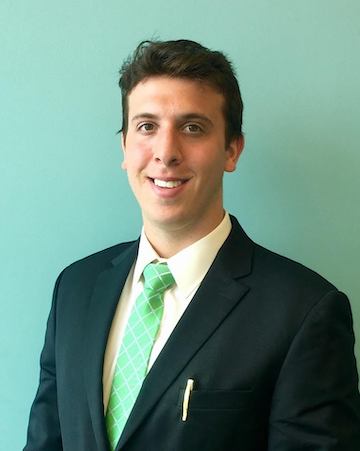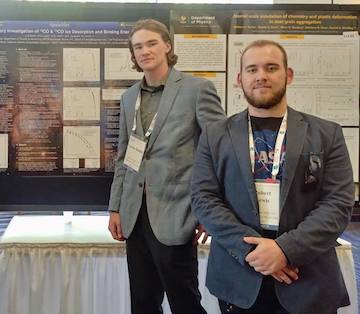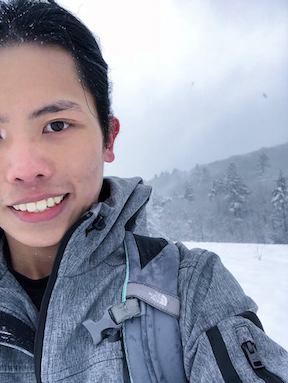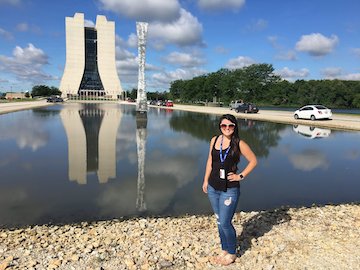Student Spotlights

Jake Poler is will be graduating at the end of this year with a BS in Physics. Last summer he was accepted into the applied physics REU at the University of South Florida in Tampa. During his time here heworked in material physics lab where he learned about a novel magnetic sensing technique using giant magneto-impedance (GMI). The high frequency GMI effect is a sensitive phenomenon found in amorphous, soft ferromagnetic materials. This effect has the potential to introduce a new class of long range, contact-free small field magnetic sensing and allows for the creation of low-cost, robust systems capable of a wide range of motion tracking applications. At the conclusion of this competitive program each student presented a 10 minute presentation on their work throughout the summer. Mr. Poler placed second overall and will potentially be traveling, fully funded, to the American Physical Society (APS) march meeting in Boston to present his findings this year.
Mr. Poler plans to pursue a Ph.D. in biophysical engineering after graduating from Appalachian. He hopes to further his education on the field of brain to computer interface (BCI). He has always wanted to help those in need and with his knowledge in this field he hopes to one day revolutionize the prosthetic industry. He wants to work towards more natural feeling and “smart” prosthetics so that the quality of life for those in need can be improved.
 Lucas Smith and Robert Lewis interned this past summer at NASA’s Jet Propulsion Laboratory (JPL) as part of the NASA-funded project, Investigating Carbon Inheritance in the Early Solar Nebula: An Interdisciplinary Approach (PI, Dr. Rachel Smith). At JPL, they conducted experiments on interstellar ice analogues with Dr. Murthy Gudipati (co-I on this project) in his Ice Spectroscopy Lab, where they investigated fractionation differences between isotopologues of CO in ice-gas reservoirs, as part of the overarching investigation that includes observations (led by R. Smith) and theoretical modeling (led by K. Willacy at JPL). Their experiments helped explore the ice and gas carbon chemistry involved in planet formation, prebiotic molecules, and forming star systems. Their experiments this summer were specifically aimed at looking at improving the measurements on the sublimation points of 12CO and 13CO, and their binding energies in the CO ice, which Lucas had begun last summer at JPL. Robert and Lucas also investigated, for the first time, the effects of photodesorption on the fractionation of CO isotopologues. Their results from this summer’s work on the precise sublimation point of CO is being prepared in a manuscript form to be published in a peer-reviewed astrophysical journal. Robert and Lucas are junior members of the American Astronomical Society (AAS), and they will be presenting a poster on this research for the Fall Division of Planetary Sciences (DPS, a subdivision of AAS) annual meeting in Knoxville, Tennessee. Lucas previously presented a poster at the 49th Lunar & Planetary Sciences Conference in Houston, which they both plan on attending again in 2019. They will also be presenting this work at a department colloquium this fall semester.
Lucas Smith and Robert Lewis interned this past summer at NASA’s Jet Propulsion Laboratory (JPL) as part of the NASA-funded project, Investigating Carbon Inheritance in the Early Solar Nebula: An Interdisciplinary Approach (PI, Dr. Rachel Smith). At JPL, they conducted experiments on interstellar ice analogues with Dr. Murthy Gudipati (co-I on this project) in his Ice Spectroscopy Lab, where they investigated fractionation differences between isotopologues of CO in ice-gas reservoirs, as part of the overarching investigation that includes observations (led by R. Smith) and theoretical modeling (led by K. Willacy at JPL). Their experiments helped explore the ice and gas carbon chemistry involved in planet formation, prebiotic molecules, and forming star systems. Their experiments this summer were specifically aimed at looking at improving the measurements on the sublimation points of 12CO and 13CO, and their binding energies in the CO ice, which Lucas had begun last summer at JPL. Robert and Lucas also investigated, for the first time, the effects of photodesorption on the fractionation of CO isotopologues. Their results from this summer’s work on the precise sublimation point of CO is being prepared in a manuscript form to be published in a peer-reviewed astrophysical journal. Robert and Lucas are junior members of the American Astronomical Society (AAS), and they will be presenting a poster on this research for the Fall Division of Planetary Sciences (DPS, a subdivision of AAS) annual meeting in Knoxville, Tennessee. Lucas previously presented a poster at the 49th Lunar & Planetary Sciences Conference in Houston, which they both plan on attending again in 2019. They will also be presenting this work at a department colloquium this fall semester.
Acknowledgement: This research was carried out at the Jet Propulsion Laboratory, California Institute of Technology, and was sponsored by the JVSRP program at JPL and the National Aeronautics and Space Administration.
Hengming Li, a Physics major with en emphasis in electrical engineering, was selected to receive a scholarship through the Appalachian High Achievers in STEM program. This program is funded by a 2018  NSFS-STEM grant and exists to attract academically talented students to STEM degrees. The program provides a nurturing atmosphere that encourages excellence and builds collaborations between students, faculty, and the community.
NSFS-STEM grant and exists to attract academically talented students to STEM degrees. The program provides a nurturing atmosphere that encourages excellence and builds collaborations between students, faculty, and the community.
At Appalachian, Li works with Dr. François Amet studying the electronic and thermal properties of materials at the nanoscale using nanofabrication techniques to design electronic devices with tailoredelectronic properties. They explore the novel phenomena that emerge in these structures at low temperatures, close to absolute zero.
Li received a National Institute of Standards and Technology (NIST) Summer Undergraduate Research Fellowship (SURF). He has been working at NIST in Gaithersburg, MD this summer on the process development of area-selective atomic layer deposition (ALD) by using a novel fluorinated polymer. This new polymer has the potential to facilitate various nanodevice fabrications.
Li is a pianist, a linguists, a tutor, a researcher, a member of the LGBTQ communitiy, and much more. After graduation, he plan to attend a Ph.D. program in order to research and explore the possibilities in the intersection of neuroscience, artificial intelligence, physics and electrical engineering.
 Mr. Jeff Miller was awarded a competitive travel award from the Society of Physics Students (SPS) and an ASU OSR travel grant to present a poster at the American Association of Physicists in Medicine meeting in Nashville, Tennessee. Miller is a senior Physics major with an emphasis in medical physics. Miller also received an NC Space Grant Undergraduate Research Fellowship for summer 2018 to work with Dr. Brooke Hester as a research assistant in the BiyOSeF research group. Miller's project is the determination of the elastic modulus of cells with optical tweezers. Optical tweezers is a technique that uses light to grab hold of small objects, manipulate them, and measure any forces that might be acting on them.
Mr. Jeff Miller was awarded a competitive travel award from the Society of Physics Students (SPS) and an ASU OSR travel grant to present a poster at the American Association of Physicists in Medicine meeting in Nashville, Tennessee. Miller is a senior Physics major with an emphasis in medical physics. Miller also received an NC Space Grant Undergraduate Research Fellowship for summer 2018 to work with Dr. Brooke Hester as a research assistant in the BiyOSeF research group. Miller's project is the determination of the elastic modulus of cells with optical tweezers. Optical tweezers is a technique that uses light to grab hold of small objects, manipulate them, and measure any forces that might be acting on them.
Senior Julia Hinds is was an intern at Fermi National Accelerator Laboratory researching with the Dark Energy Survey – Gravitational Waves group.
“I am working on DES-GW (Dark Energy Survey - Gravitational Waves) pipeline for imaging subtraction between DECam (Dark Energy Camera) and PanSTARRS (Panoramic Survey Telescope and Rapid Response
System),” Julia said. “One already exists for DECam images but not for PanSTARRS. By adding PanSTARRS images, we increase our overall sky coverage. It will help us fill in the gaps where we do not have DECam images. The detection of electromagnetic (EM) and gravitational-wave (GW) emission from astrophysical sources is one main events present day astronomers hope to achieve. GW events have several possible progenitors, including black hole mergers, cosmic string cusps, supernovae, neutron star mergers, and black hole - neutron star mergers. The LIGO-Virgo Collaboration has agreed to send GW alerts as well as coordinates of these gravitational events, so by using the DES-GW pipeline, the EM counterparts can be pursued. We hope to run a test event at the beginning of August."